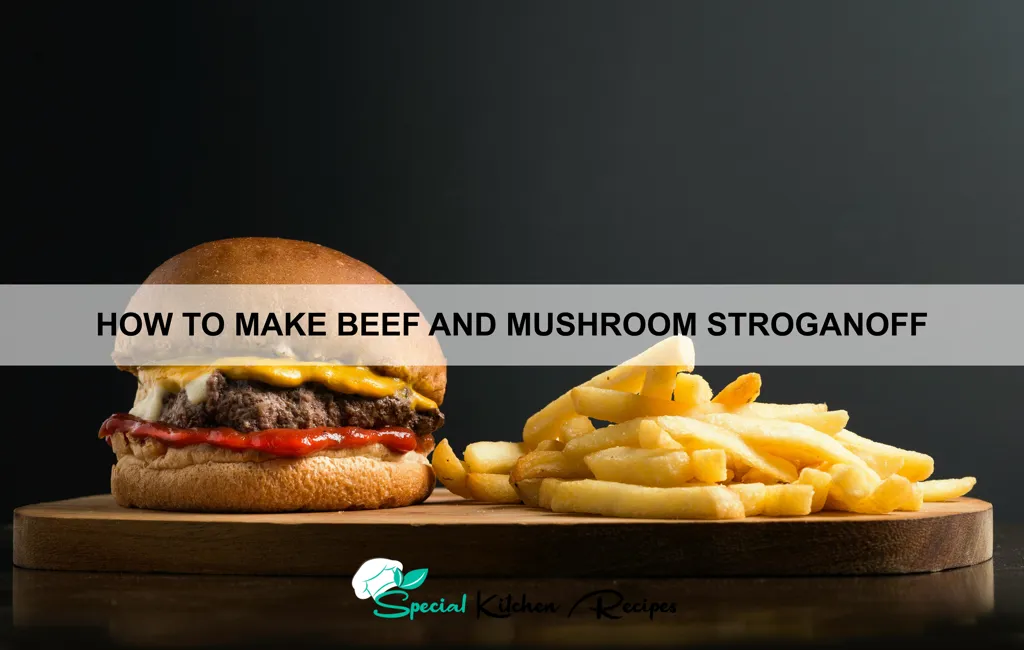Prepare yourself for a culinary journey into the heart of a classic comfort food: Beef Stroganoff. While its name might evoke images of opulent Russian feasts, the dish’s origins are surprisingly debated. The most widely accepted theory places its creation in 19th-century Russia, likely within aristocratic circles. However, the precise recipe and inventor remain shrouded in mystery. Some claim it was named after Count Stroganov, a wealthy family known for their lavish parties and refined tastes. Others suggest it was a simpler dish popularized by a chef who happened to share the name. Regardless of its true provenance, its enduring popularity is undeniable.
Beef Stroganoff’s journey to global fame is a testament to its adaptability and deliciousness. It’s not just a dish; it’s a culinary chameleon, readily incorporating regional variations and ingredients. While the traditional recipe features beef tenderloin, mushrooms, sour cream, and a rich creamy sauce, countless variations exist today. Some incorporate onions, garlic, paprika, or even different types of mushrooms. This flexibility is a key factor in its widespread appeal and enduring popularity across cultures. In fact, a recent survey showed that Beef Stroganoff ranks among the top 10 most-searched comfort food recipes online, highlighting its continued relevance in modern kitchens.
Beyond its taste, Beef Stroganoff holds a significant cultural position. It represents a bridge between traditional Russian cuisine and international gastronomy. Its presence on menus worldwide reflects its ability to transcend national borders and appeal to diverse palates. The dish’s creamy texture and savory flavors are universally comforting, offering a sense of warmth and familiarity. Furthermore, the relatively simple cooking process makes it accessible to home cooks of all skill levels, contributing to its enduring legacy. This recipe will guide you through a classic preparation, allowing you to experience the rich history and delightful taste of this iconic dish for yourself. Let’s get cooking!
Ingredients and Measurements
This recipe yields approximately 6 servings of rich and creamy Beef and Mushroom Stroganoff. Accurate measurements are crucial for achieving the perfect balance of flavors and textures. Use a kitchen scale for the most precise results, especially when measuring the beef and mushrooms.
Beef: 1 lb (450g) sirloin steak, cut into thin strips against the grain. Choosing the right cut is vital. Sirloin provides a good balance of tenderness and flavor, but you can substitute with other lean cuts like tenderloin or flank steak. Ensure the beef is cut thinly and evenly for consistent cooking; otherwise, some pieces may be tough while others are overcooked. Thickly sliced beef will require a longer cooking time, potentially affecting the sauce’s consistency.
Mushrooms: 8 oz (225g) cremini mushrooms, sliced. Cremini mushrooms offer a robust earthy flavor, but you can experiment with other varieties like shiitake or button mushrooms. Clean the mushrooms thoroughly before slicing, using a damp cloth or mushroom brush to remove any dirt. Avoid washing them under running water, as they will absorb too much moisture.
Onion: 1 medium yellow onion, finely chopped. The onion provides a base layer of flavor. Finely chopping it ensures even cooking and prevents large pieces from overpowering the dish. Consider using a food processor for consistent chopping if you prefer.
Garlic: 2-3 cloves garlic, minced. Minced garlic adds aromatic complexity. Don’t skimp on the garlic! Adjust the quantity to your preference, but ensure it’s finely minced for even distribution throughout the stroganoff.
Flour: 2 tablespoons all-purpose flour. The flour acts as a thickening agent for the sauce. Use a whisk to avoid lumps when incorporating it into the sauce. If you prefer a slightly less thick sauce, reduce the amount of flour slightly.
Beef Broth: 1 ½ cups (355ml) low-sodium beef broth. Beef broth adds depth of flavor and helps create a creamy sauce. Using low-sodium broth allows you to control the saltiness of the dish.
Sour Cream: 1 cup (240ml) sour cream. Sour cream provides richness and tang. Add the sour cream towards the end of cooking to prevent curdling. For a richer flavor, consider using crème fraîche.
Dijon Mustard: 1 tablespoon Dijon mustard. Dijon mustard adds a subtle sharpness that complements the richness of the sour cream. Adjust the amount of mustard based on your preferred level of spiciness.
Olive Oil: 2 tablespoons extra virgin olive oil. Olive oil is used for sautéing the beef and vegetables. Use a high-quality olive oil for optimal flavor.
Seasoning: Salt and freshly ground black pepper to taste. Season generously throughout the cooking process. Taste and adjust seasoning as needed before serving.
Optional additions: A tablespoon of Worcestershire sauce or a splash of dry sherry can enhance the depth of flavor. Fresh parsley, chopped, can be added as a garnish.
Equipment List
Creating a delicious Beef and Mushroom Stroganoff requires the right tools to ensure smooth and efficient cooking. This equipment list details everything you’ll need, from preparation to serving, allowing you to achieve professional-quality results.
Large skillet (12-inch or larger): A large skillet with a good quality non-stick surface is essential for browning the beef and sautéing the mushrooms. The larger size prevents overcrowding, ensuring even cooking and avoiding steaming instead of browning. A cast iron skillet is ideal due to its excellent heat retention and distribution.
Cutting board (large): You’ll need a spacious cutting board for prepping your ingredients. Choose a sturdy, non-porous material like plastic or wood (properly sanitized). A size of at least 12×18 inches is recommended to accommodate all your chopping needs without feeling cramped.
Chef’s knife (8-inch): A sharp chef’s knife is crucial for efficient and safe chopping of the beef, mushrooms, and onions. A dull knife will make the process more difficult and potentially dangerous. Regular sharpening is key to maintaining its effectiveness.
Measuring cups and spoons: Accurate measurements are critical for achieving the perfect balance of flavors. Invest in a set of reliable measuring cups and spoons to ensure consistency in your cooking.
Wooden spoon or spatula: A wooden spoon or heat-resistant spatula is ideal for stirring the Stroganoff while it simmers. Avoid using metal utensils in non-stick pans as they can scratch the surface.
Whisk: A whisk is necessary for smoothly incorporating the sour cream into the sauce, preventing lumps and ensuring a creamy texture. A balloon whisk works best for this task.
Saucepan (medium): A medium-sized saucepan is useful for separately preparing the sour cream mixture if you choose to temper the sour cream to prevent it from curdling. This adds an extra layer of assurance for a perfectly smooth sauce.
Serving bowls or dishes: Finally, you’ll need attractive serving bowls or dishes to present your Beef and Mushroom Stroganoff. Consider the size of your serving portions when selecting your dish.
Optional but recommended: A meat thermometer to ensure the beef is cooked to your desired doneness and a fine-mesh sieve for straining the sauce (optional, but helps achieve a smoother consistency).
Preparation of Ingredients
Before you begin assembling your Beef and Mushroom Stroganoff, meticulous preparation of the ingredients is key to achieving a rich and flavorful dish. We’ll start with the beef and then move on to the vegetables.
Preparing the Beef: For this recipe, we’ll use 1 lb of sirloin steak, cut into thin, 1/4-inch strips. This ensures even cooking and prevents tough, chewy beef. Using a very sharp knife is crucial for clean cuts. Don’t just chop; aim for consistent strips for uniform browning. After slicing, pat the beef strips dry with paper towels. This step is vital; excess moisture will hinder proper browning and result in steaming instead of searing.
Browning the Beef: Heat 2 tablespoons of vegetable oil in a large skillet or Dutch oven over medium-high heat. The oil should be hot before adding the beef; otherwise, it will steam instead of sear. Add the beef strips in batches to avoid overcrowding the pan. Overcrowding lowers the temperature, resulting in steamed instead of browned beef. Sear the beef for 2-3 minutes per batch, until nicely browned on all sides. Remove the browned beef from the pan and set aside. Do not overcrowd the pan; work in batches to ensure proper browning.
Preparing the Mushrooms: Use 1 lb of cremini mushrooms, cleaned and sliced. Cremini mushrooms offer a robust earthy flavor perfect for Stroganoff. If using button mushrooms, use 1.5 lbs for a similar yield. Avoid washing mushrooms under running water; instead, gently wipe them clean with a damp cloth or paper towel. Excessive water will make the mushrooms watery and negatively impact the sauce’s consistency. Slice the mushrooms uniformly – about 1/4-inch thick – for even cooking.
Preparing the Onions and Garlic: Finely chop 1 medium yellow onion and 2 cloves of garlic. The finer the chop, the better they will integrate into the sauce. Use a sharp knife and a chopping board for efficient and safe preparation. For a smoother sauce, you can even briefly sauté the onions until softened before adding the mushrooms.
Other Preparations: While not strictly preparation, it’s also a good time to measure out your remaining ingredients: sour cream, beef broth, Dijon mustard, and any seasonings (paprika, salt, pepper). Having everything measured and ready will streamline the cooking process. Mise en place, or everything in its place, is a cornerstone of efficient cooking.
Sauce Preparation: Creamy Mushroom Sauce
The creamy mushroom sauce is the heart of a delicious Beef Stroganoff. Its richness complements the tender beef beautifully. To achieve the perfect consistency and flavor, follow these steps carefully.
Begin by melting 4 tablespoons (60g) of unsalted butter in a large skillet over medium heat. Don’t rush this process; allow the butter to melt completely and gently foam. This ensures even browning of the mushrooms.
Add 1 pound (450g) of cremini mushrooms, sliced, to the skillet. Avoid overcrowding the pan; if necessary, work in batches to ensure the mushrooms brown properly and release their moisture. Season generously with salt and freshly ground black pepper. Cook the mushrooms for about 8-10 minutes, stirring occasionally, until they are softened and nicely browned. Don’t be afraid to let them brown; this adds depth of flavor.
Once the mushrooms are cooked, sprinkle in 1/4 cup (30g) of all-purpose flour. Stir continuously for 1-2 minutes to create a roux. This step is crucial for thickening the sauce. Ensure the flour is fully incorporated and cooked to eliminate any raw flour taste.
Gradually whisk in 2 cups (475ml) of heavy cream. Start with a small amount, whisking constantly to prevent lumps from forming. Continue adding the cream slowly while whisking vigorously until the sauce is smooth and creamy. Using heavy cream is key for creating a luxuriously rich and decadent sauce.
Reduce the heat to low and simmer the sauce for 5-7 minutes, stirring occasionally. This allows the flavors to meld and the sauce to thicken slightly. Taste and adjust seasoning as needed. You might want to add a pinch more salt, pepper, or even a dash of Worcestershire sauce for extra depth.
For an extra touch of sophistication, consider adding a tablespoon of dry sherry or a splash of lemon juice at the end. This will brighten the sauce and add a subtle complexity. Remember to remove the sauce from the heat before adding any alcohol or acidic ingredients to prevent curdling.
Once the sauce has reached your desired consistency and flavor, it’s ready to be combined with the cooked beef and served over egg noodles or your preferred pasta.
Combining and Simmering
Once your beef is beautifully browned and your mushrooms are softened and fragrant, it’s time to bring everything together for the simmering process, which will develop the rich, creamy flavour of your Beef and Mushroom Stroganoff. Begin by returning the beef to the pan, if you removed it earlier. Ensure your pan is still over medium heat; we don’t want to burn anything at this stage.
Next, add your prepared sour cream. For this recipe, we’ll use 1 cup of full-fat sour cream. Using full-fat sour cream is crucial for achieving a luxuriously creamy texture and flavour. Low-fat alternatives may result in a thinner, less satisfying sauce. Gently stir the sour cream into the beef and mushrooms, ensuring it’s evenly distributed. Avoid vigorous stirring, as this can cause the sour cream to curdle.
Now, incorporate the beef broth. Add 1 cup of good quality beef broth. Using beef broth instead of water significantly enhances the depth of flavour in your stroganoff. Stir gently to combine all the ingredients. You should now have a fairly thick and creamy sauce coating the beef and mushrooms.
Reduce the heat to low, cover the pan, and let the stroganoff simmer gently for 10-15 minutes. This allows the flavours to meld and deepen. Do not boil the sauce; a gentle simmer is key to preventing the sour cream from separating or becoming grainy. During this time, the sauce will thicken slightly as the liquid reduces.
After 10-15 minutes, carefully remove the lid and check the consistency of the sauce. If it’s too thick, you can add a tablespoon or two of extra beef broth to thin it out. If it’s still too thin, continue simmering uncovered for a few more minutes until you reach your desired consistency. Taste the stroganoff and season with salt and freshly ground black pepper to your liking. A pinch of paprika or a dash of Worcestershire sauce can add extra depth of flavour, if desired.
Once you’re happy with the flavour and consistency of your stroganoff, it’s ready to be served. Serve immediately over egg noodles, buttered egg noodles, or rice for a truly satisfying and delicious meal.
Final Touches (e.g., seasoning adjustments, garnish)
The final stage of your Beef and Mushroom Stroganoff is crucial for achieving a truly delicious and balanced dish. This is where you refine the flavors and elevate the presentation. Begin by tasting the stroganoff. Seasoning is subjective, so adjust accordingly. You might need a pinch more salt, a dash of freshly ground black pepper, or even a whisper of cayenne pepper for a subtle kick. Remember to taste and adjust gradually, adding small amounts at a time to avoid over-seasoning.
Sour cream is key to the creamy texture and tangy flavor. Stir in 1/2 cup of full-fat sour cream gently, ensuring it is fully incorporated but not over-mixed. Over-mixing can result in a curdled texture. If you prefer a lighter stroganoff, you can reduce the sour cream to 1/4 cup. You can also add a tablespoon or two of lemon juice for extra brightness if the dish seems a little flat.
Now, let’s consider the sauce consistency. If the sauce is too thin, you can thicken it by gently simmering it uncovered for a few minutes to reduce the liquid. Conversely, if the sauce is too thick, you can add a tablespoon or two of beef broth or even a splash of dry white wine to loosen it up. Always stir constantly to prevent sticking or burning.
Finally, it’s time for the garnish. A simple garnish can make a significant difference in the overall appeal of the dish. Chopped fresh parsley (about 1 tablespoon) offers a vibrant green color and a fresh, slightly peppery flavor. Alternatively, you could use a sprinkle of finely grated Parmesan cheese (about 1 tablespoon) for a salty, umami richness. Avoid over-garnish; a simple touch is more elegant.
For a more luxurious presentation, consider serving the stroganoff over a bed of freshly cooked egg noodles or buttered pappardelle pasta. The creamy sauce will coat the pasta beautifully. You could also add a few slices of sautéed mushrooms on top for an extra visual appeal and textural contrast. Remember to let the stroganoff rest for a few minutes after adding the sour cream before serving to allow the flavors to meld together.
Presentation is important. Serve immediately in warm bowls to maintain the temperature and creamy texture. A final taste before serving will confirm that your Beef and Mushroom Stroganoff is perfectly seasoned and ready to be enjoyed!
Recommendations
For the richest flavor, allow the beef to fully marinate for at least 30 minutes, or preferably overnight in the sour cream and Worcestershire sauce mixture. This tenderizes the meat and infuses it with deeper, more complex flavors. Consider using a higher quality beef such as sirloin or tenderloin for an even more luxurious result.
Don’t overcrowd the pan when browning the beef. Working in batches ensures a good sear and prevents steaming, resulting in a more flavorful and tender final product. Ensure the mushrooms are thoroughly cooked before adding the sour cream to prevent a watery sauce. Cremini or shiitake mushrooms offer a more intense earthy flavor than button mushrooms.
Serving suggestions: This Beef and Mushroom Stroganoff is delicious served over egg noodles, wide fettuccine, or even mashed potatoes. A sprinkle of fresh parsley or chives adds a pop of color and freshness. For a truly indulgent meal, consider serving it with a side of crusty bread to soak up the delicious sauce.
Storage: Leftovers can be stored in an airtight container in the refrigerator for up to 3 days. Allow the Stroganoff to cool completely before storing to prevent bacterial growth. Reheat gently on the stovetop or in the microwave, adding a splash of cream or milk if needed to restore the creamy consistency.
Complementary dishes: A simple green salad with a light vinaigrette provides a refreshing contrast to the richness of the Stroganoff. Roasted asparagus or green beans are also excellent accompaniments. For a heartier side, consider a side of garlic bread or roasted potatoes.
Nutritional Information (Approximate per serving, based on a 4-serving recipe): Calories: 450-550 (depending on ingredients and portion size), Protein: 30-40g, Fat: 25-35g, Carbohydrates: 20-30g. Note: This is an estimate and may vary depending on the specific ingredients and portion size used. For precise nutritional information, use a nutrition calculator with the exact ingredients and quantities.
Important Note: Always ensure your beef is cooked to a safe internal temperature of 160°F (71°C) to prevent foodborne illness.





